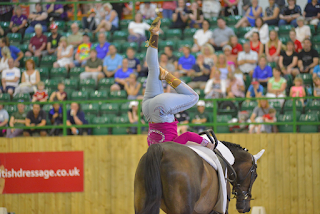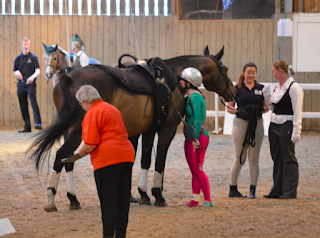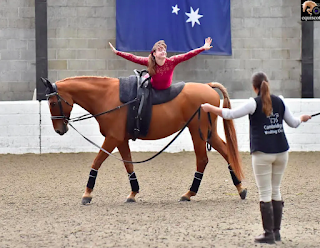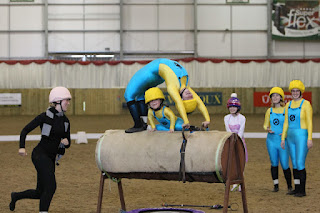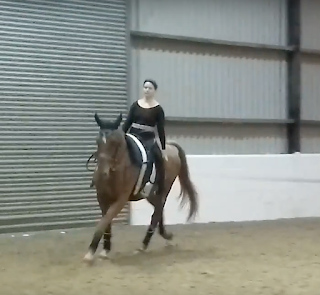The shortest answer to the question, "What is vaulting?" is that vaulting is an equestrian sport which combines dance and gymnastics on the back of a moving horse. It has ancient origins and an exciting future! Para vaulting is simply the sport of vaulting for disabled people. It is judged in the same way as the mainstream, non-disabled sport, and can present both the same challenges and the same opportunities.
Para vaulting can be...
- performed on a vaulting barrel or a real horse
- performed in walk, trot and/or canter
- extremely adaptable for many different types of disabilities
- an opportunity to improve an individual's physical and mental health
- a team sport and/or an individual sport
- creative and artistic
- an art and a science
- a fabulous way to bond with the horse
- a great means to improve confidence around horses, including for riders
What makes vaulting so good for disabled people?
Activity of any kind is great for the mental and physical health of all of us, disabled or not. Vaulting has a number of benefits in this regard, including improving...
- flexibility
- balance
- strength
- co-ordination
- timing
- poise, control and elegance
- cardiovascular fitness/endurance/stamina
- explosive muscle power
- confidence in movement
- teamwork
- social skills
- communication
- imagination and creativity
- musicality
- artistry
- empathy with the horse and other vaulters
- telling a story
- The vaulter does not have to worry about controlling the horse - a lunger does that. In vaulting, the horse moves in a circle, controlled by a person standing in the middle of the circle - the lunger. The lunger holds a whip in one hand and the lunge line in the other, which is a bit like a very long dog lead which attaches to the horse's bridle. The lunger is in control of the horse so the vaulter is able to focus on themselves and their harmony with the horse rather than telling the horse what to do. This makes the sport much safer for people who are very young or who have more severe disabilities.
- The vaulter has a roller to help them when they are on the horse. Unlike a saddle, the roller has big handles which are easy to grasp if the vaulter loses a bit of balance.
- The vaulter doesn't have to sit astride. Some disabled people are unable to sit astride on a horse. Some may be able to ride side saddle, but access to saddles and appropriately experienced horses is hit and miss. In vaulting, however, it is not necessary to sit astride to take part in training and to put together a freestyle routine. Even when vaulters do sit astride, this tends not to be for very long, which can make it more manageable for some.
- The vaulter is able to have support from on board the horse. In regular vaulting, up to three people are allowed to be on the horse at any one time (provided the horse is strong enough to carry the people in question). In RDA vaulting, two are allowed to be mounted at once. Even when just one extra person is mounted, they can offer a huge amount of support to the vaulter that would not be possible from the ground. This enables those with more severe disabilities to take part, and also makes it easier for less disabled vaulters to learn more challenging moves (e.g. standing).
- In vaulting sessions, we tend not to spend very long on the horse at a time. In a standard riding lesson, you would expect to be on board for around 30 minutes, but in a vaulting session you only do a few minutes at a time at most. This means that it is a good way to build up fitness and the body's physical tolerance without people getting too tired. It should be noted, though, that a few minutes of intense vaulting can be every bit as challenging as a much longer ride!
- Another benefit of vaulting over riding for disabled people is that vaulting both requires and develops so many different skills. While very few people would have all of the skills listed above, almost everyone will have some strengths in there, which they can use to improve their own performance and to work with others. For example, my own balance leaves a lot to be desired but my flexibility is pretty good. Similarly, one person may not be very strong but they might be extremely musical and elegant. In a vaulting team, those strengths are drawn together, but it also means that, even when we compete as individuals, we are drawing on lots of the things that we can do well, even if at first glance they seem unrelated to vaulting.
What are the differences between para vaulters and non-disabled vaulters?
Para vaulters do whatever non-disabled vaulters do! We are all judged in the same way in competition. Clearly adaptations and allowances have to be made at times, e.g. permitting a different way of mounting, but other times we just have to work with what we have to be as close to the 'perfect model' as possible - just like the non-disabled vaulting community.
A good coach will ensure that their vaulters are pushed to develop as athletes in a way that is safe and successful. The coach will not draw attention to things that cannot be changed, because of an individual's disability, but will find the strengths their vaulter has and maximise those, as well as giving support and encouragement to make changes where they are possible.
Coaches should be able to see that there are times when a person's disability actually gives them an advantage over others. For example, an individual with dwarfism may have a lower-than-average centre of gravity, which can lead to confident balancing in extremely impressive moves. Other gymnasts who lack flexibility in some respects may have beautiful 'lines' (e.g. leg extension). Vaulters with certain neurodevelopmental conditions can give stunning performances which offer a real insight into their world.
In the world of vaulting, anything and everything can help. Being able to draw out the positives and to find ways to manage the negatives are two traits that are essential for any vaulting coach, but particularly those working with disabled vaulters.
What competition opportunities are open to para vaulters in the UK?
In the UK, we have two systems of competition open to disabled vaulters: the RDA (Riding for the Disabled Association) and BEV (British Equestrian Vaulting). There are many similarities between the two:
Individuals (all RDA competitions, and Pre-Novice BEV competitions)
- Two routines: 'Compulsories' and 'Freestyle'
- Compulsories: Basic seat, bench and leg lifts performed with music in the background. No time limit for this routine.
- Freestyle: A routine comprising moves that are not compulsory moves. It should tell a bit of a story and a costume that matches the music should be worn. 1 minute time limit for this routine.
At RDA competitions, the individual events can be completed on the barrel, on the horse in walk, on the horse with compulsories in canter and freestyle in walk, or on the horse with both routines in canter.
In BEV competitions, compulsories can be in walk, trot or canter and the freestyle can be in walk or trot. For vaulters showing canter freestyles, there is a separate set of compulsories which are more difficult. After that level, vaulters compete at FEI 1*.
Pairs
In both RDA and BEV competitions, para pairs are performed in walk on the horse. The vaulters only need to show a freestyle routine (no compulsories), which must be performed to music. It has a 90 second time limit.
Team
In RDA, the team routine can be performed on the barrel or on the horse. There are no compulsories; instead the team must show a freestyle routine which has a 4 minute time limit. There should be 6 members of the team, of whom 2 are permitted to be non-disabled RDA volunteers (but this is optional; all 6 can be disabled if desired). Teams can be 'composite', i.e. composed of vaulters from a range of different RDA Groups. Up to two vaulters can be on the horse/barrel at any one time, and the horse/barrel should never be 'empty' at any point during the routine (no vaulters up).
In BEV, there are two main options for para teams: the Walk Team and the Pre-Novice Team.
The walk team can have 4-8 members, all of whom must be disabled (unlike the RDA team). They perform a 4-minute routine on the horse in walk. 4 minutes is the maximum time allowed, so the team can be shorter if desired.
The Pre-Novice team has 6 members, all of whom must be disabled. The team performs canter compulsories and then their 4-minute freestyle in walk.
So what do para vaulters actually do?
Here are some moves to show you, starting with compulsories:
Basic seat
Bench
Leg lift
A quick video showing just my basic seat and bench from the 2017 British Vaulting Championships (I don't know what happened to the leg lifts!).
